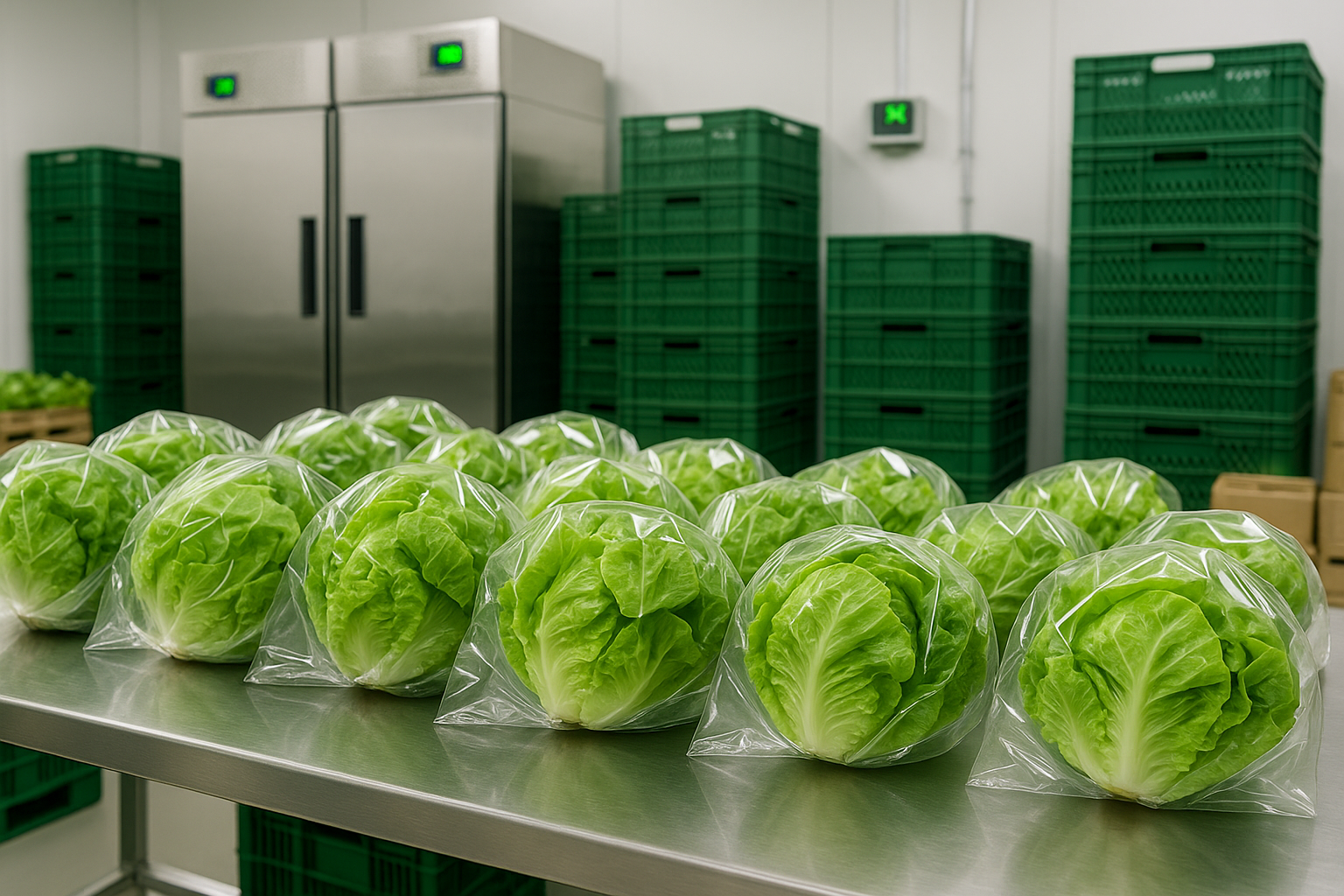Introduction
Packaging lettuce for sale isn’t just about tossing greens into a box and hoping for the best—proper handling determines whether your lettuce arrives at market crisp, fresh, and appealing or wilted and unsellable. The journey from farm to shelf is filled with challenges: lettuce is notoriously sensitive to temperature and moisture, easily bruised, and quick to spoil if mishandled.
For growers and retailers alike, maintaining quality and extending shelf life means higher profits and happier customers. Even a few hours of improper handling can turn a fresh harvest into a loss. Imagine unboxing a shipment only to find soggy, browning leaves—that’s a scenario both sellers and buyers want to avoid. Luckily, with careful attention to detail, the risk can be minimized.
Effective packaging of lettuce for sale involves not only using the right containers to prevent crushing but also managing temperature by cooling lettuce quickly after harvest. Keeping humidity levels optimal with breathable liners or perforated bags helps prevent wilting without encouraging rot, while careful stacking during transport avoids damaging the delicate leaves. Monitoring every stage, from washing and drying to boxing and loading, helps preserve that just-picked crispness buyers crave.
In this post, we’ll cover the smartest strategies for packaging and moving fresh lettuce, from tools and materials to expert tips on cooling, moisture control, and safe shipping. Whether you’re a small-scale farmer or supplying a bustling grocery chain, these practical steps ensure your lettuce travels safely from field to customer—looking as good as it tastes.
Harvesting and Preparing Lettuce for Packaging
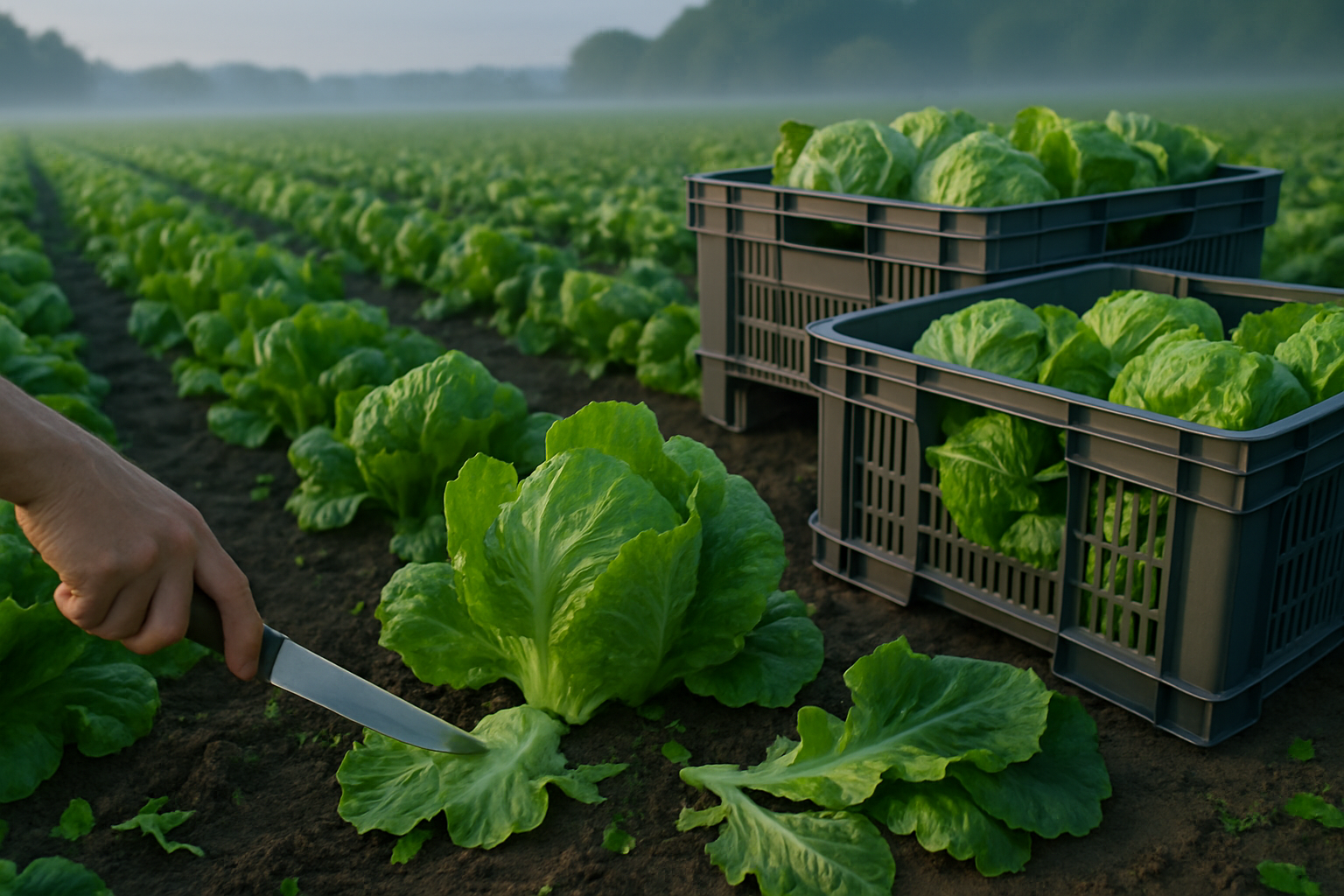
Harvesting lettuce at the right stage is crucial for quality—aim for firm, well-formed heads or full, tender leaves, depending on the variety. The best time to harvest is early morning when temperatures are cooler, as this helps preserve moisture and keep the lettuce crisp. Use a sharp knife or sanitized scissors to cut the heads or leaves cleanly at the base, avoiding excess bruising.
Immediately after harvesting, protect lettuce from the sun and field heat by placing it in shaded, cool bins or crates; heat stress can cause rapid wilting and spoilage.
Once indoors, begin the washing process by gently rinsing lettuce in clean, cold water to remove dirt, insects, and debris. Agitate the leaves lightly but avoid rough handling to prevent bruising. Sort through the lettuce, removing any damaged, wilted, or slimy leaves—this helps improve both appearance and shelf life. Trimming excess stems or outer leaves also makes packaging easier and more appealing.
After washing and sorting, rapid cooling—also known as pre-cooling—is vital. Submerge lettuce in chilled water or use forced-air cooling; this drops the core temperature quickly and slows microbial growth.
To prevent soggy leaves and future mold, always dry the lettuce completely with a salad spinner, clean towels, or air dryers. Never seal wet lettuce in packages; moisture trapped inside creates the perfect environment for rot.
Once dry, package the lettuce in breathable bags or containers that help maintain freshness but allow excess moisture to escape. For best results, store packaged lettuce in a refrigerated environment as soon as possible.
By combining these steps—timely harvesting, thorough cleaning, quick cooling, and careful drying—you can ensure your lettuce stays crisp, clean, and ready for market or kitchen use.
Choosing the Right Packaging Materials
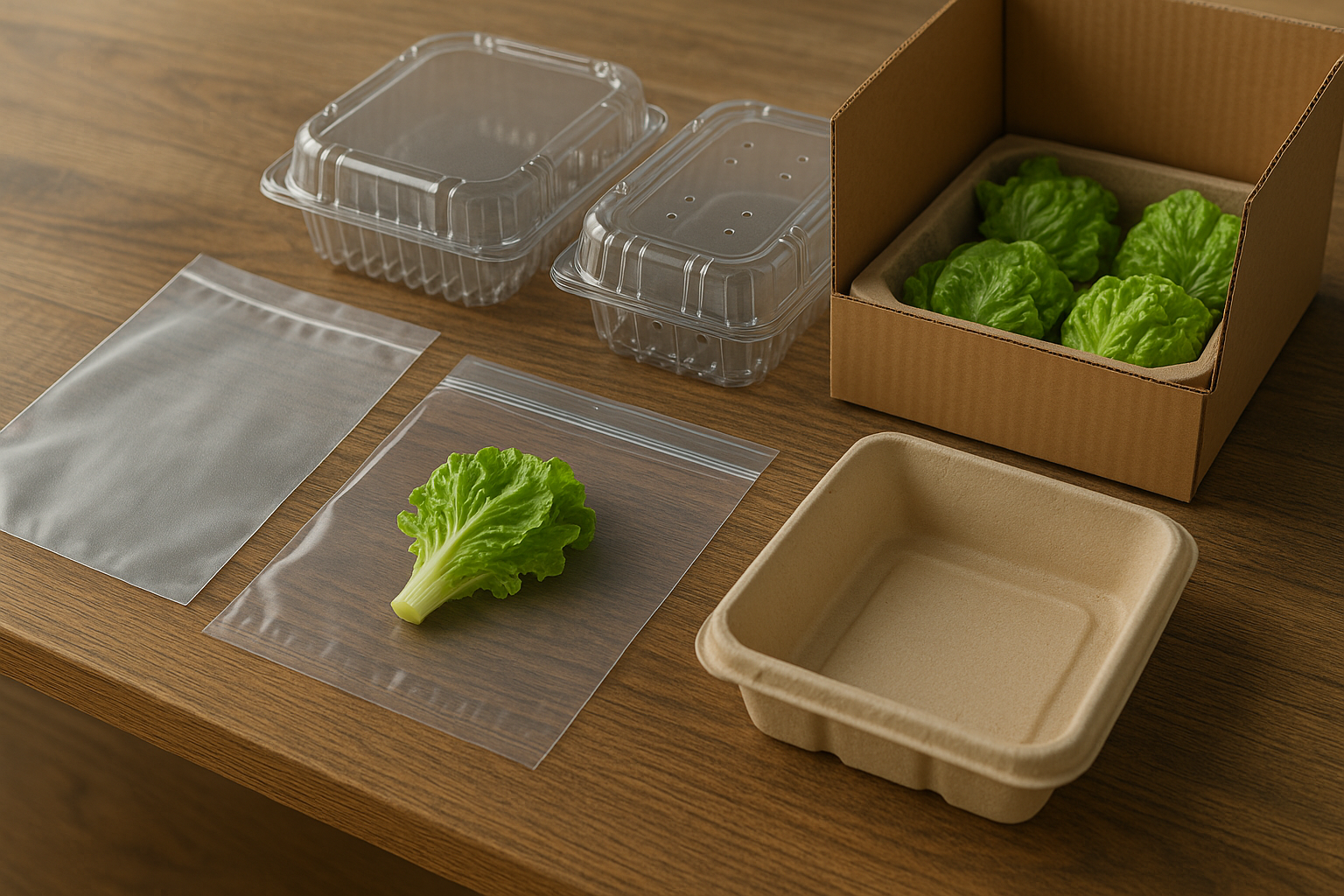
Choosing the right packaging materials for produce isn’t just about keeping items contained—it’s about balancing freshness, presentation, and your brand’s image.
Take plastic bags, for instance: BOPP (biaxially oriented polypropylene) and OPP (oriented polypropylene) are clear, flexible choices that offer decent moisture protection and are often used for greens and herbs. Anti-fog variants prevent moisture droplets from clouding the view of your products, making them ideal for high-moisture fruits and vegetables that benefit from visibility.
Clamshells, those hinged plastic containers, offer excellent protection and stackability, making them perfect for berries or cherry tomatoes. However, they can be less eco-friendly and sometimes trap excess moisture unless they feature vent holes.
Corrugated boxes are a sturdy, versatile option for bulk and transport but typically need liners or inserts to ensure goods don’t dry out or become bruised.
Vented sleeves and bags are specifically designed to encourage airflow with strategically placed holes, which is crucial for items like mushrooms or leafy greens that wilt quickly when moisture builds up.
In recent years, eco-friendly alternatives—such as compostable films or fiber-based cartons—have gained traction, appealing to environmentally conscious consumers and helping your brand demonstrate sustainability commitments.
Whichever material you choose, remember to consider breathability—vent holes and moisture control features help extend shelf life and reduce waste.
Finally, don’t overlook branding and compliance: packaging is prime real estate for eye-catching labels that showcase your logo, nutritional information, and required certifications like organic or non-GMO. Smart labeling not only attracts customers but ensures you meet retail and regulatory requirements, so design with both impact and accuracy in mind.
The right combination of protection, presentation, and brand messaging will keep your produce—and reputation—in top shape from farm to shelf.
Proper Techniques for Packing Lettuce
To keep lettuce fresh and appealing, careful packing is essential. Start by gently handling heads or leaves, avoiding squeezing or bruising them—lettuce, especially looseleaf and hydroponic varieties, bruises easily, and rapid handling can ruin quality.
Arrange romaine and iceberg lettuce with their core ends facing down, keeping them upright in the packaging to prevent moisture from pooling and to minimize weight on tender leaves. For looseleaf lettuces, loosely layer them with minimal overlap, using food-safe liners or perforated bags to allow air flow while keeping leaves separated. Hydroponic lettuce, often more fragile with exposed roots, should be kept in supportive clamshells or trays that cushion and separate each plant.
No matter the type, never overpack; crowding restricts ventilation, causing excess moisture that leads to rot. Always pre-chill packaging materials and storage areas to about 32–36°F (0–2°C), maintaining 95–100% relative humidity. This slows wilting and keeps lettuce crisp. However, avoid condensation by not letting cold lettuce sit out at room temperature before final sealing.
Throughout the process, practice strict hygiene—use gloves, wash hands, and keep surfaces sanitized to curb contamination, which can accelerate spoilage. Minimize how often each piece is touched by assigning specific packing tasks to each worker or by using tools like lettuce knives or tongs.
Whether working with a small garden harvest or in a commercial pack house, these methods ensure your lettuce maintains its vibrant look, crisp bite, and shelf life—helping it go from farm to fork in peak condition.
Efficient Storage and Cold Chain Management
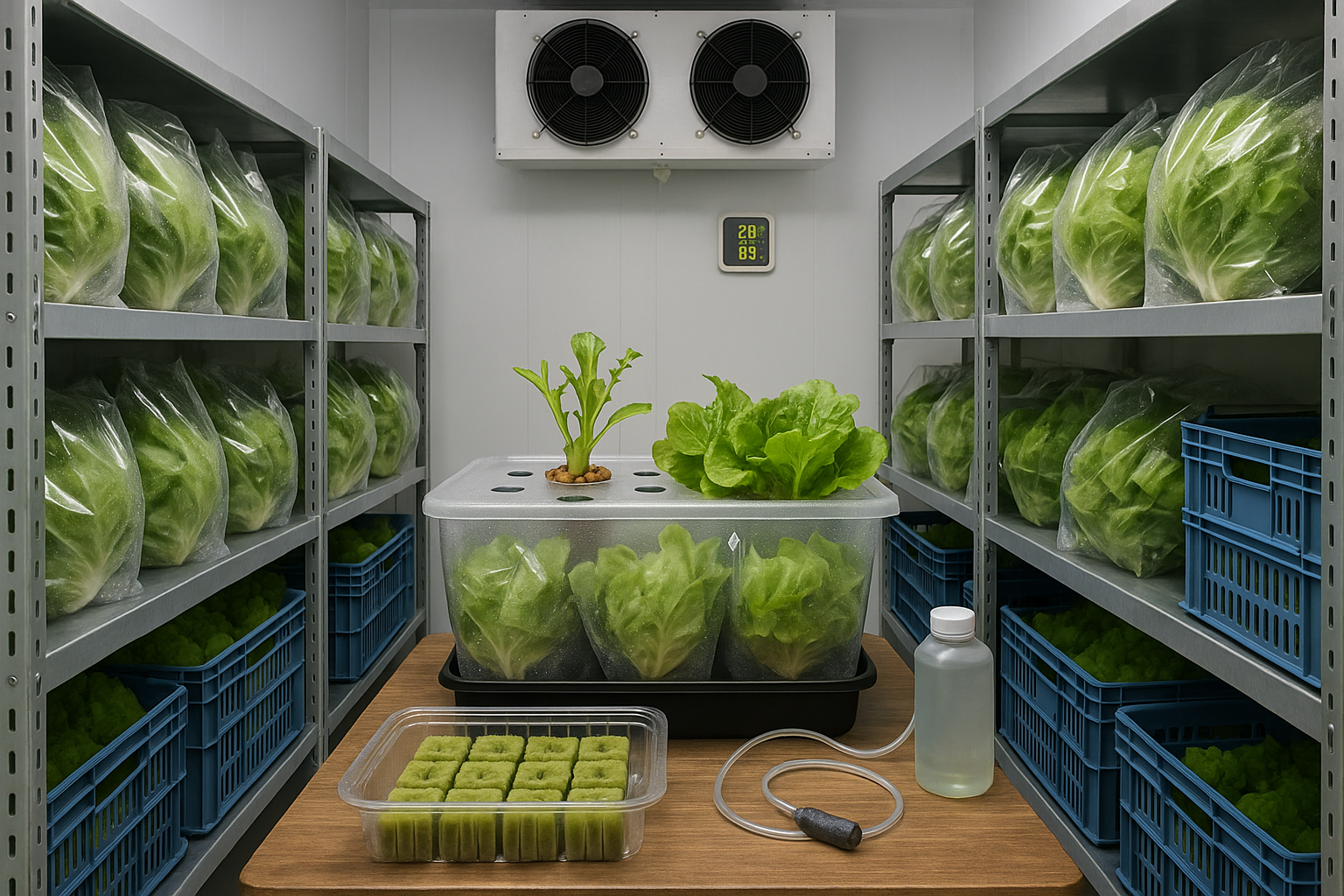
Maintaining an efficient cold chain from the field to the endpoint is crucial for preserving the quality and shelf life of perishables. The moment produce is harvested, it starts to lose freshness, so rapid post-harvest handling is essential.
In the packhouse, immediately transfer products to pre-cooled storage to minimize exposure to higher temperatures that can accelerate spoilage. Always aim to keep storage temperatures within the optimal range for your specific commodity—for many fruits and vegetables, this can vary between 0°C and 13°C—while avoiding freezing.
Consistent airflow is just as important as temperature; ensure shelving or crates allow for good circulation so cold air reaches every item evenly. Humidity should also be managed—high enough to prevent dehydration and shriveling, but not so high that condensation and mold become a problem.
Many packhouses use digital hygrometers and temperature loggers to continuously monitor and record conditions. If you notice signs like wilting, discoloration, condensation inside packaging, or off-odors, these are early warnings that the cold chain may be breaking down.
Always check for leaks in the cooling system, malfunctioning fans, or blocked air vents when these issues crop up. Train staff to act fast at the first sign of temperature spikes or equipment failures by moving at-risk produce to backup storage or using portable coolers.
Even during loading or transport, keep doors closed as much as possible to maintain stable conditions. By keeping these best practices in mind and regularly checking the health of your storage environment, you’ll dramatically reduce product losses and deliver fresher, higher-quality produce to your customers every time.
Safe and Effective Transportation Methods
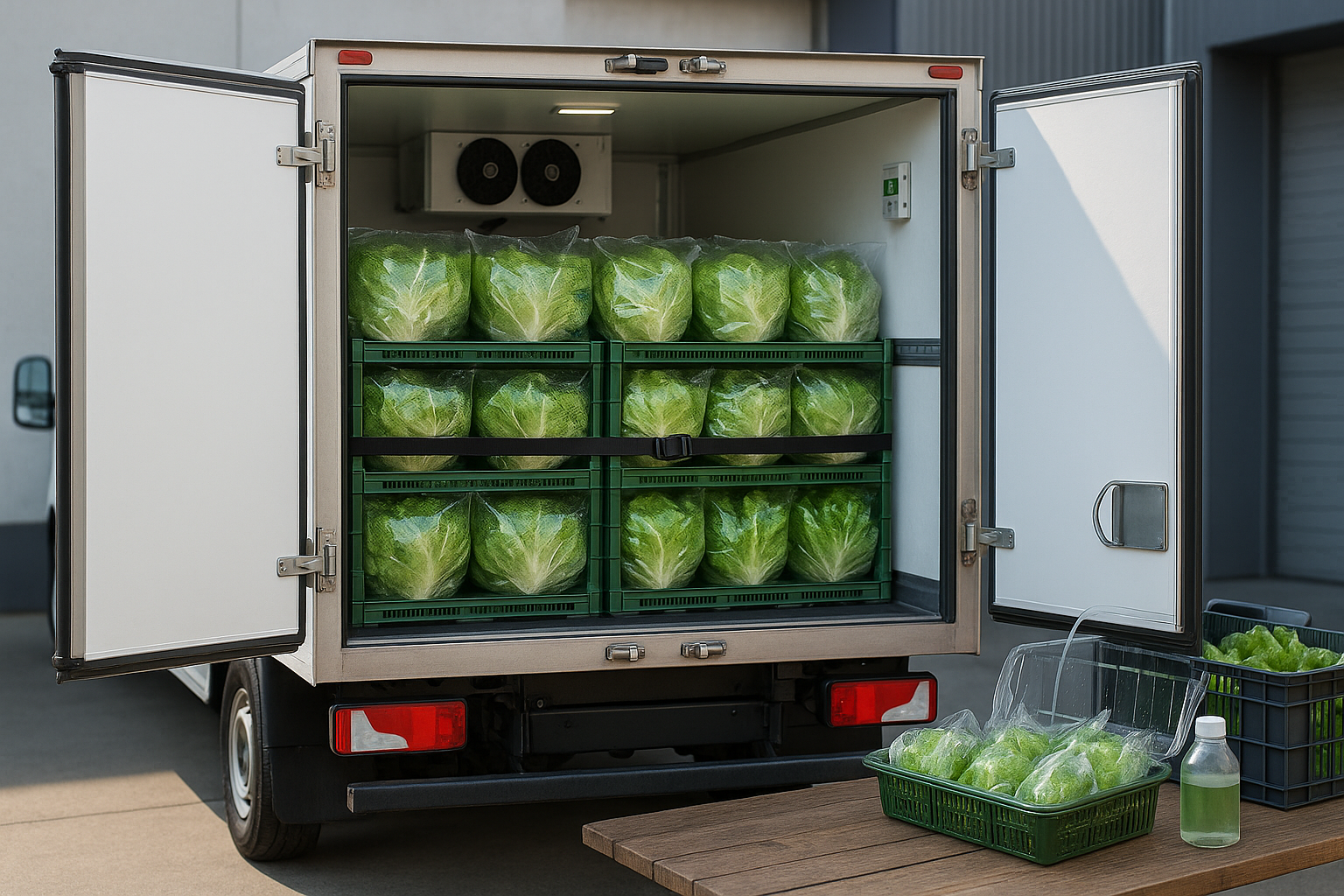
When transporting packaged lettuce, choosing the right method depends on the distance and the sensitivity of your cargo. For short hauls—like deliveries to local grocers or restaurants—insulated vans are often sufficient. These vehicles help maintain a cool environment but may rely on cold packs to keep lettuce fresh for several hours.
For longer distances, refrigerated trucks with built-in temperature controls are essential. They maintain a consistent 34–38°F (1–3°C), which is ideal for lettuce. Modern trucks often feature real-time temperature monitoring and alarms so drivers can react quickly if there’s a fluctuation.
When loading, always place lettuce in sturdy, clean crates and avoid stacking too high or too tightly, as proper air circulation is key to preventing overheating and spoilage. It’s smart to line the floor with slip-resistant mats and secure crates with straps or netting to reduce movement and bruising during transit. Consider arranging heavier items on the bottom and lighter crates on top, leaving aisles for airflow.
Documentation is just as important as the physical process: each shipment should be accompanied by a bill of lading and clear, weatherproof labels that include the product name, origin, packed date, and temperature requirements. For traceability, many use QR codes that link to digital logs detailing every step from harvest to delivery. This allows quick action in case of a recall or quality issue.
A Simple Checklist to Ensure You’re Covered
- Double-check temperature logs before departure
- Confirm all crates are labeled and documented
- Keep records organized for quick reference
By combining the right transport equipment, careful packing, and robust documentation, you can deliver lettuce that stays crisp, safe, and fully traceable—no matter how far it travels.
Common Packaging Problems and How to Avoid Them
When it comes to packaging, some of the most frequent problems include crushing, wilting, condensation, and damage caused by poor temperature control.
Crushing
Crushing often happens when packages are overstacked or lack inner supports. To prevent this, switch to sturdier boxes, use dividers, or lower stack heights.
Wilting
Wilting, especially with fresh produce, usually results from excess moisture or airflow issues. Choose breathable packaging materials and avoid sealing items too tightly. Simple perforations can provide just enough ventilation to keep items fresh.
Condensation
Condensation is another major problem, often triggered by temperature fluctuations or poorly insulated packaging. To prevent this, pre-chill products before packing, use moisture-absorbing liners, and ensure your packing area matches your storage temperature.
Damage from Cold Chain Lapses
Damage from cold chain lapses typically occurs when there are gaps in refrigerated storage or shipping. Always use temperature loggers to monitor the cool chain, and opt for insulated containers with gel packs or dry ice during longer transports.
Quick Fixes and Best Practices
- Label cartons with “this side up” and “fragile” to avoid mishandling.
- Repack items with extra padding if you notice any weaknesses.
- Invest in regular training for your packing team.
- Keep packing areas clean and conduct routine quality checks.
Even small tweaks to your packing process—like mixing in dent-resistant inserts or replacing old insulation—can significantly reduce spoilage and keep your goods in top condition, ultimately enhancing product quality and customer satisfaction.
Conclusion & Key Takeaways
Proper packaging and transport are essential for maintaining the quality and appeal of fresh lettuce. Start by choosing clean, ventilated packaging materials that prevent bruising and allow airflow—plastic crates or perforated bags work well.
Always keep the lettuce cool, ideally between 0°C and 4°C, from farm to market. This slows spoilage and preserves crispness. Handle each head gently, stacking carefully to avoid crushing, and remove excess field heat quickly after harvest.
Maintain cleanliness at every step to reduce contamination and the risk of foodborne illness. Real-world success comes from setting up scheduled cold-chain checks and providing regular staff training on best practices.
By prioritizing these steps, you can dramatically extend shelf life, maintain lettuce safety, and present consistently fresh produce that attracts buyers and boosts repeat sales. Investing time and attention during packaging and transportation pays off by ensuring your customers always receive lettuce at its peak—crisp, nutritious, and ready for the plate.
